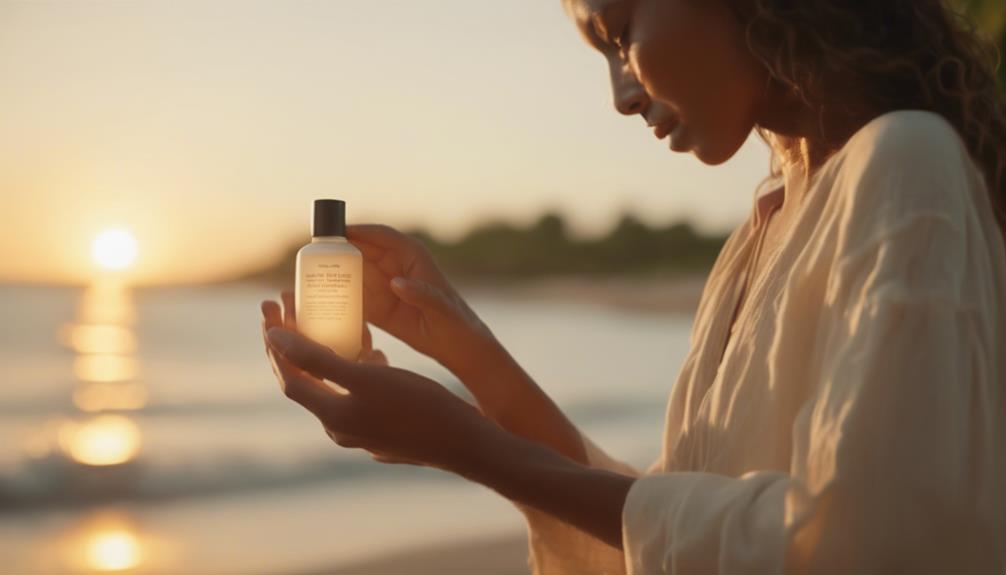Timing your tan is key, so let's break it down! If you've got fair skin, give yourself 4-6 weeks to build up a golden glow without turning into a lobster. Olive skin? You're good to go in just 2-4 weeks. Dark skin can start as soon as 1-2 weeks before you're aiming to shine. Remember, start slow with shorter sessions and bump it up gradually! Don't forget to check that UV index and slather on that SPF—nobody wants a sunburn! So, if you're curious about those tips to keep your tan looking fab, stick around for more awesome info!
Key Takeaways
- Fair skin should start tanning preparations 4-6 weeks before the desired date to prevent burns and achieve an even tan.
- Olive skin types can begin their tanning routine 2-4 weeks in advance for optimal results.
- Dark skin only requires 1-2 weeks of preparation before tanning to ensure a smooth application.
- Gradual sun exposure is crucial; start with shorter sessions and increase duration over time.
Understanding Skin Types
How well do you know your skin type, and why is it essential for achieving the perfect tan?
Knowing your skin type is like having a secret weapon in the tanning game!
Fair skin? You'll need to start tanning about 4-6 weeks in advance.
Olive skin? You can get away with just 2-4 weeks.
Dark skin? Lucky you—1-2 weeks is all you need!
Each skin type reacts differently to the sun, so understanding this can save you from looking like a lobster or a patchy mess.
You want that sun-kissed glow, not a sunburn disaster!
Plus, starting with shorter sessions and gradually increasing your time is key.
Tanning and UV Ray Intensity

Understanding your skin type helps you navigate the varying intensity of UV rays, which can greatly impact your tanning results. UV rays are strongest in summer, so be careful!
If you have fair skin, start slow to avoid a lobster look—trust me, no one wants that. Olive and dark skin can usually handle a bit more sun, but always check the daily UV index. It's like the weather report but for your skin!
Don't forget sunscreen—SPF 30 or higher is your best friend. Reapply every two hours, especially if you're splashing around in the pool.
Keep an eye on your skin too; if you notice any redness or irritation, it might be time to chill out for a bit. Your skin will thank you!
Pre-Tanning Skin Preparation

Preparing your skin for tanning is essential to achieve a smooth and even glow.
First things first, exfoliate! It's like giving your skin a fresh start, especially those rough spots like elbows and knees. You don't want to end up with a patchy tan, right?
After scrubbing, make sure to slather on some moisturizer to keep your skin hydrated. That's a must! Ideally, you should exfoliate about 24 hours before your tanning session to let your skin breathe.
And don't forget—consistent moisturizing is your friend in the days leading up to your tan.
If you're not ready to brave the sun, consider sunless options like spray tans. Who doesn't want a fabulous tan without the sunburn?
Enjoy the glow!
Recommended Tanning Timelines

After you've gotten your skin ready with proper exfoliation and moisturizing, it's important to know the right timelines for tanning based on your skin type. You don't want to be caught off guard with a last-minute glow-up!
Here's what you should consider:
- Fair skin: Start 4-6 weeks before your big event.
- Olive skin: You can kick things off 2-4 weeks ahead.
- Dark skin: Just 1-2 weeks will do the trick!
- Frequency: Aim for about three sessions a week.
Aftercare for Your Tan

To keep your tan looking vibrant and fresh, proper aftercare is essential.
First off, slap on some specialized post-tan lotion to keep your skin moisturized and repair any dryness. Trust me, no one wants a patchy tan!
You should also apply sunscreen consistently, even if you think you're “golden” already.
And hey, be gentle when exfoliating; skip the harsh scrubs that might ruin your hard work.
Want to keep that glow? Limit sweaty activities like intense workouts or hot yoga for a bit.
Hydration is key, so drink plenty of water.
Remember, you've put in the effort, and you deserve to show off that beautiful tan without any hiccups!
Who doesn't want to shine?
Maintaining Your Tan

Keeping your tan vibrant requires consistent care and attention to your skin's needs. You don't want all that hard work to fade away, right? Here's how to keep that glow going strong:
Moisturize daily: Hydration is key; dry skin can lead to a patchy tan.
Use sunscreen: Protect your tan while keeping your skin safe from UV damage.
Avoid harsh scrubs: Exfoliate gently to remove dead skin without losing your color.
Drink plenty of water: Staying hydrated helps your skin look fresh and radiant.
Limit sweaty activities: Excessive sweating can make your tan fade faster, so maybe skip the gym for a while!
Trending Tanning Topics

Here are some of the hottest trends in tanning that you won't want to miss.
First off, everyone's buzzing about proper tanning bed cleaning—because who wants to bake on a dirty bed, right?
Next, check out the best tanning bed goggles for 2024; protecting your peepers is a must!
Oh, and if you're thinking about pre-tanning bed prep, there's a buzz around the key steps to get your skin ready.
Plus, don't forget about those cute tanning bed face covers—they're all the rage for UV protection!
Finally, if you're struggling with freckles or uneven tones, there are guides to help you manage those tanning-related skin issues.
Frequently Asked Questions
What Are the Best Indoor Tanning Products to Use?
When choosing indoor tanning products, look for lotions that enhance moisture and promote tanning, like bronzers or accelerators. Always check for ingredients that suit your skin type to achieve the best results without irritation.
How Can I Tell if My Tan Is Fading?
Did you know that tans can fade up to 50% in just a week without proper care? Check for unevenness, dullness, or dryness to determine if your tan's fading, and adjust your skincare routine accordingly.
Can Diet Affect My Tanning Results?
Yes, your diet can affect tanning results. Eating foods rich in antioxidants, like fruits and vegetables, helps protect your skin. Staying hydrated also supports even tanning, so drink plenty of water for best results.
Are There Any Medications That Interfere With Tanning?
Have you ever wondered why your tan doesn't develop as expected? Certain medications, like antibiotics or acne treatments, can hinder tanning. Always check with your doctor to verify your skin's health isn't compromised while tanning.
How to Fix an Uneven Tan?
To fix an uneven tan, gently exfoliate the lighter areas, then apply a self-tanner for an even tone. Moisturize regularly to maintain balance, and avoid excessive sun exposure to prevent further unevenness.
Conclusion
So, there you have it! Timing your tan is all about knowing your skin type and planning ahead.
Did you know that people with fair skin can burn in just 10 to 15 minutes? Yikes! That's why it's super important to prep and protect your skin.
Follow these tips, and you'll rock that sun-kissed glow while keeping your skin happy and healthy.
Now go out there and show off your bronzed beauty—just don't forget the sunscreen!










